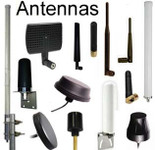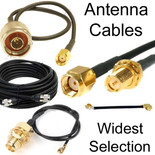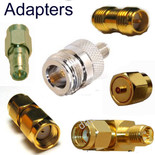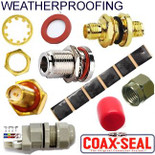Technical Support for Antennas & Related Gear
LMR-400 Coax Specifications / Characteristics: Lowest Signal Loss in Its Class
LMR-400 Coax Cable Specifications
Structure: LMR-400 is a 50-ohm coaxial cable that was originally made to replace lower quality coax cables such as the RG-8. The 400 represents the cable diameter. The LMR-400 actually has a diameter of 0.405 or 10.29 mm though it is classified as a 400, similar to most coaxial cables in its class such as the RG-8 types, all of which measure .400.
Low Loss: LMR-400 is distinguished from other antenna cables in the market for its low loss characteristics. It has the lowest signal-loss among its class and compared to most semi-rigid and hard-line cables.
- For example: LMR-400 loses 0.04 dB / ft. at 900 MHz as compared to 0.32 dB / ft. for the RG-174
Frequency Bands: LMR-400 is excellent at frequencies greater than 1Ghz as its attenuation properties are custom made for such frequencies. If you have a radio with 1.2 GHz or more, then you should find that the LMR is your best option given that your traditional RG series does not work with anything above 1 GHz.
Conductivity: The insulators are made of tinned oxygen free copper that also come with foil conductor tapes. These are bonded directly onto the insulator thus providing a double-shielded coaxial cable conductor that is effective at all times.
Double Shielding: Due to its double bonded foil, the attenuation (signal loss) is significantly lower as compared to single shielded coaxial cables: RF shielding of LMR-400 is > 90 db as compared to 40 dB for RG8.
Connectors: LMR 400 is compatible with a lot of connectors that include most of the common interface modes such as non-solder and solder and reverse polarity pins. Most LMR compatible connectors use standard hex crimp sizes for outer attachment crimps.
Flexibility: The 400 is far less flexible than LMR-200 and LMR-100 coaxial cables.
Black PVC Jacket: Just like many others in the LMR standard comes with an Ultraviolet resistant Polyethylene jacket. Combined with an aluminum alloy that is plated with an oxygen-free copper, it is highly flexible and resistant to the elements that it can last for up to 20 years of outdoor service.

LMR-400: A Deep Dive into Its Features and Applications
Coaxial cables, or simply coax cables, remain central to the realm of radio-frequency (RF) communication. With a plethora of choices available, the LMR-400 stands out for several compelling reasons. Catering especially to high-frequency applications, the LMR-400 coax cable has carved a niche for itself. This article ventures into the specifics of the LMR-400, examining its features, materials, applications, and its aptitude for IoT systems.
Key Features:
- Diameter: The LMR-400 boasts a substantial diameter of approximately 10.29mm, making it robust and suitable for various applications.
- Impedance: Like many standard coax cables, the LMR-400 adheres to the 50 ohms impedance benchmark.
- Velocity of Propagation: It presents an impressive 85%, ensuring swift data transmission.
- Attenuation: With its low-loss characteristics, LMR-400 ensures optimal signal strength, especially over extended distances.
Materials Composition:
At the core of the LMR-400 is its double-shielded material composition, designed for signal performance:
- Center Conductor: Typically, this is made of solid bare copper or copper-clad aluminum, ensuring efficient signal transmission.
- Dielectric: Gas-injected foam polyethylene provides the insulating layer, facilitating the high velocity of propagation.
- Shielding: Dual shielding is a standout feature. An initial bonded aluminum foil is 100% coverage, followed by a tinned copper braid which offers both physical durability and further protection against interference.
- Jacket: An external black polyethylene (PE) jacket encompasses these layers, providing resistance against UV, making it apt for outdoor applications.
Types:
Beyond the standard LMR-400, variations have been crafted for specific needs. There's the LMR-400-UF (Ultra Flex) for situations demanding more flexibility, and the LMR-400-DB designed explicitly for direct burial without needing conduits. There's also the LMR-400-FR, which is fire-retardant, suitable for in-building applications.
Compatible Wireless Technologies & Protocols:
The prowess of LMR-400 isn't limited to a singular application. It seamlessly integrates with:
- Cellular Technologies: Covering 2G, 3G, 4G, and even 5G applications.
- Wi-Fi Systems: Being an integral part of Wi-Fi infrastructure installations.
- Radio Systems: Used extensively in ham radio and other RF applications.
- Satellite Communication: Given its low attenuation, it's optimal for satellite dish feeds.
Applications & Suitability for Specific IoT Applications:
In the expanding world of IoT, connectivity is paramount. The LMR-400's low loss, high frequency, and robust build make it a front runner:
- Commonly used in these cable assembly types and applications:
- To connect an SMA antenna to a router by means of an SMA cable such as an SMA extension cable.
- RP-SMA cable assemblies to connect an RP-SMA antenna to a bridge or router by means of an RP-SMA extension cable.
- IoT Infrastructure: For sprawling IoT networks, especially in urban areas where long cable runs might be necessary, LMR-400 ensures minimal signal loss.
- Outdoor Sensors & Devices: Given its UV-resistant jacket, the LMR-400 is apt for outdoor IoT sensors, including weather stations or smart agriculture sensors.
- Smart Buildings & Campuses: With variations like the LMR-400-FR, it's safe for indoor applications, linking various IoT devices in smart buildings.
Conclusion:
When diving into the world of coaxial cables, the LMR-400's features make it a stalwart. Its meticulous design, broad-spectrum application, and suitability for IoT installations make it more than just a cable; it's an investment in reliable connectivity. Whether it's ensuring a steady Wi-Fi connection, setting up an extensive IoT network, or even dabbling in radio systems, the LMR-400 stands ready to deliver. As the digital age propels forward, equipping oneself with robust tools like the LMR-400 isn't just wise; it's essential.








